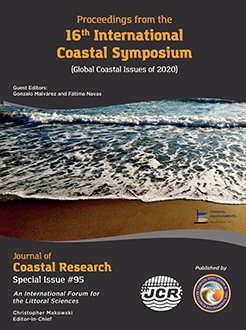Carvalho, B.C. and Guerra, J.V., 2020. Coastal vulnerability of Rio de Janeiro shoreline (SE Brazil) due to natural and social impacts. In: Malvárez, G. and Navas, F. (eds.), Global Coastal Issues of 2020. Journal of Coastal Research, Special Issue No. 95, pp. 759–763. Coconut Creek (Florida), ISSN 0749-0208.
The vulnerability of two sectors from the Rio de Janeiro coastline (SE Brazil), related to coastal erosion and inundation, is assessed in this work: the Marambaia barrier island (MBI), a 40 km long feature with scarce human occupation, and the 20 km long Macumba/Recreio-Barra (MRB) beaches, that are variably urbanized. Although MBI is classified as an area predominantly with low vulnerability (40%), its Central and Easternmost sectors exhibit high vulnerability (35%). Macumba beach western sector exhibits low vulnerability (44%); in contrast, its eastern sector is very highly vulnerable (44%). The same tendency is observed at Recreio-Barra beaches, which present a trend of increasing vulnerability from west (22% with moderate vulnerability) to east, where >50% of its extension is very highly vulnerable. The geomorphology of the coastline, represented by a low topography, associated to significant wave height >1.5m and a microtidal regime, led to its classification as highly and very highly vulnerable to coastal erosion and inundation (>50%). At MRB beaches, where the anthropic influence is larger than along MBI, the coast is more exposed to coastal erosion and inundation, especially in scenarios of global increasing storminess and sea level rise.





